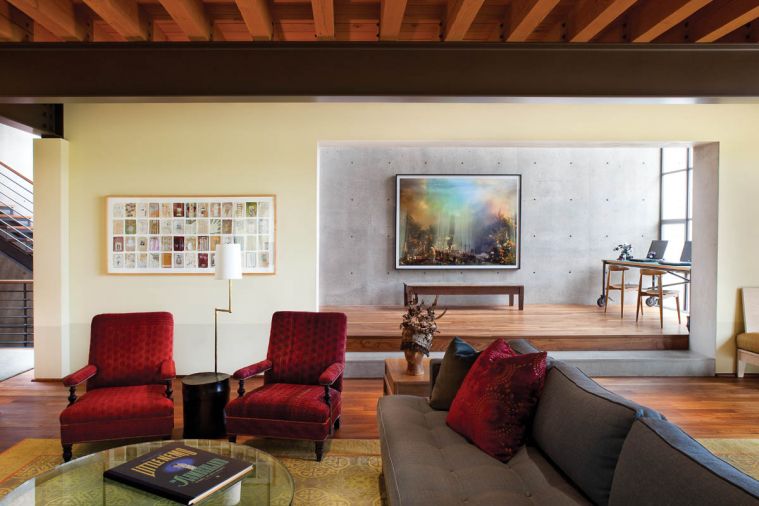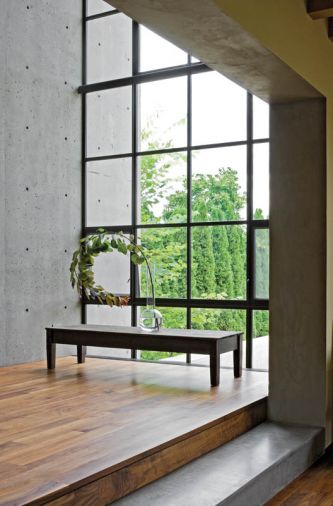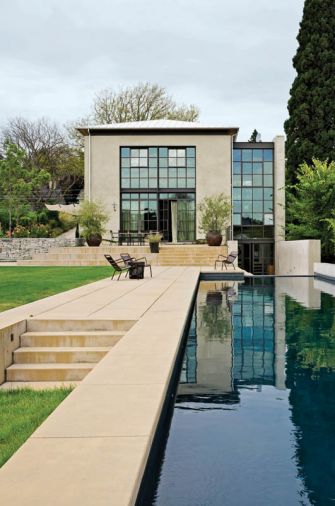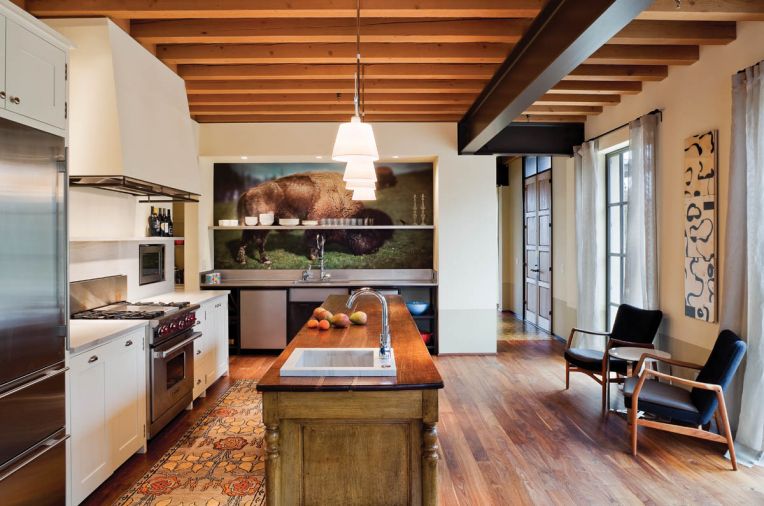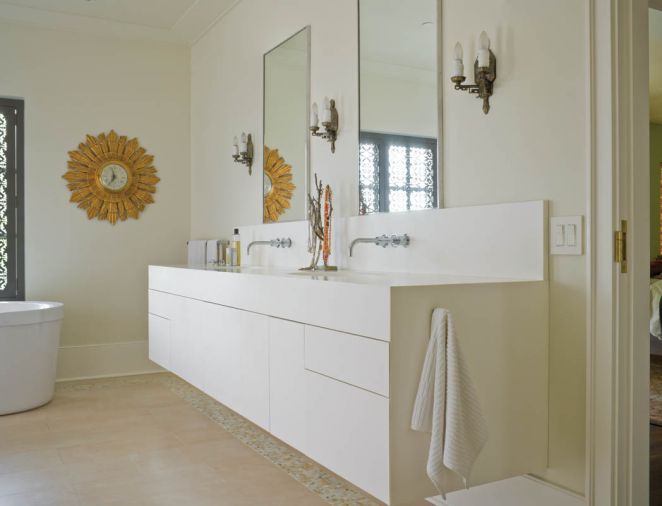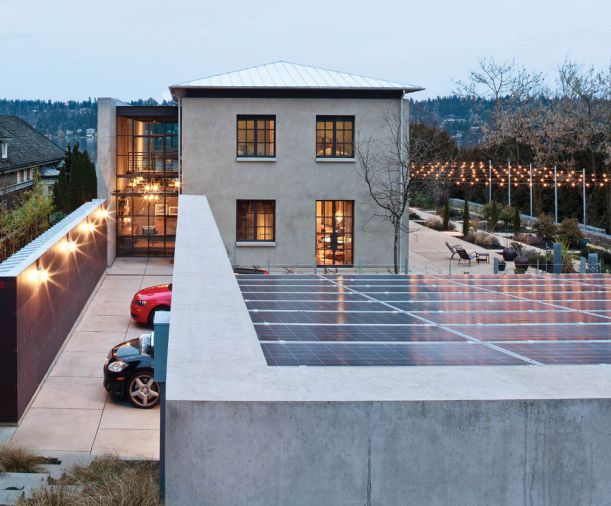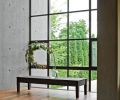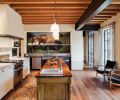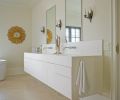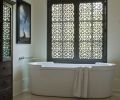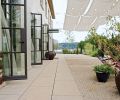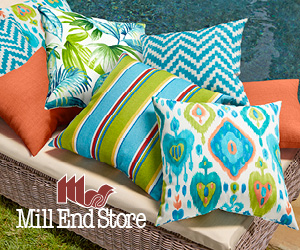Blending disparate aesthetic elements to create a cohesive, engaging whole is one of the most persistent challenges in contemporary design. But at Seattle’s Southpaw home, architects Christopher Osolin, Jim Replinger, and Tim Hossner teamed up with designer Janice Viekman to create a home that draws from influences hundreds – even thousands – of years apart: classical to industrial, contemporary to antique, resulting in a home that artfully straddles yesterday and today.
Situated on a lake shore, this 5,000 square foot home was built in 2005. Owned by a couple with eclectic tastes and a willingness to push established boundaries, the home is a treasure trove of unique design concepts and striking juxtapositions.
Even the siting of the building itself is unusual. Many houses on its street face the lake directly, creating a physical and visual barrier between the entry of the home and the water view – something Osolin calls a “visual dam.” The Southpaw home, on the other hand, is oriented perpendicular to the lake on its nearly one-acre site, making the water visible from the street while opening up the feel of the lot. “Most lakefront houses want to maximize the view of the lake by turning the broad side of the house towards it, but then you cut your entire site off. So we took the whole house and turned it sideways. It created three distinct zones: An entry court/parking area, a formal entry garden to the south, and the front of the home that faces the lake. You can walk down the site and enjoy the lake view from its whole width.”
The design phase for the Southpaw house was unusually long, and unusually complex. The home’s owners, a couple, brought a lot of different design preferences to the table, and it took careful, thoughtful planning to integrate those preferences into a cohesive whole. A strong preference for British Regency architecture, which favors rectilinear structures, symmetrical layout, and classical design motifs was expressed early on in the design phase, as well as a desire to integrate contemporary industrial materials like concrete and steel. “The house is really an amalgamation of those ideas,” says Osolin. “In its structure, it’s the combination of a French villa and a contemporary modern house. To make it work we had to distill out the key components from both of their different ideas, and marry them together so it wouldn’t look like a collision.”
In addition to these strong, linear components, the homeowners brought a love of color, texture, and pattern to the design table. One of the homeowners is a collector of antique textiles, and is particularly interested in Moroccan design. Both loved bright color deployed with a whimsical approach, and both needed the home to serve as a backdrop for their existing collection of antique furniture. “I had a tour through their existing home early on, and their desire for an unexpected juxtaposition of old and elaborate with new and modern was immediately evident,” says designer Janice Viekman.
“In Palladian architecture, you’re drawing on history, so in the interior I looked for a way to include that alongside modern elements. In the master bathroom, the floor tile pattern ignores the big walk-in shower. Instead of breaking at a curb and making the shower its own pattern, I made the floor pattern absolutely contiguous and unbroken, as if it was the entire room and the shower had been put in later. It’s a way of creating historical stories that aren’t entirely real, giving the house some instant history even though it’s brand new. There was a bit of storytelling about that.”
The northern wall of the home is anchored by an interior-exterior concrete wall. “It was very challenging to build,” says Osolin. “It had to be made in one big pour, and it took something like 14 hours to pour that wall. It was a big challenge for us and for the contractor, and they did a spectacular job.” The concrete is a statuesque visual and physical anchor for the home, and also acts as a reflector, capturing light that enters the house from its south side and diffusing it throughout the home.
That massive concrete wall also delineates one edge of what the architects called “the Slot,” a glass-enclosed structure on the north side of the home that houses a truly remarkable staircase, fabricated by Tod Von Mertens. During the design phase, the staircase was one of the more difficult elements to resolve. Inspiration from the Viennese Secessionist movement, an artistic movement inspired by the early industrial era that took advantage of new methods of forming concrete and working with metal, finally pointed the way to a design that fused elements of industry and craft.
To complement the strong architectural lines, the homeowners selected a vibrant palate of orange, yellow, peach, and red to extend throughout the home. “I’ve never had such a big paint schedule!” says Viekman. “The architecture made it easy to have a lot of color. There are no ambiguous transitions. Between each room are these very architecturally designed, cleanly defined portals that transition to secondary hallways as well as other rooms. So it’s very easy to begin and end different colors, since you don’t normally want to just end a color on an outside corner and then pick up another.”
Inspired by the homeowner’s love of textiles, pattern and repetition also play a central role. In the master bathroom, a custom-made laser-cut shutter brings texture and rhythm into a room otherwise characterized by a soothing color and material palette. After sourcing straight panels from a company in England, Viekman designed a shutter and hardware system. The shutter also provides filtered light into the tub area while also preserving a sense of privacy.
On the main floor, the living room was carefully designed to maximize flexibility. A modular approach to design, including embedding power outlets in the floor throughout the space, was important to the homeowners, who wanted to be able to reconfigure furniture and layout for holidays and entertaining.
The main dining table was designed by Viekman after some surprise inspiration from part of the construction process. To apply the stucco on the exterior of the home, the architects subcontracted to a well-established stucco firm in the Seattle area. The boards they used in their scaffolding were coated in decades of concrete dust, creating a weathered patina that contrasted beautifully against the industrial scaffolding frame.
Inside, Viekman created a table built on a pipe system and mounted on scaffolding wheels. The homeowners wanted a table that was large enough for entertaining, easy to move, and integrated technology so they and their children could use it for computer work. The completed table was pre-wired for power, making it easy to use technology as well as electric lamps, instead of candles. Like so much of the house, the ultimate design sprung from the fusion of seemingly disparate elements. “It was a complicated set of circumstances that led to a very specific design direction,” says Viekman. “The design came out of a desire to throw in an industrial element, to mix together Palladian architecture with a working environment with a factory/industrial look, some functional requirements, and the desire for an eclectic mix of things within the home.
“Compatibility as a team – client, architect, and designer – is really critical to a project working,” says Viekman. And while it’s not always easy to combine disparate elements into an integrated whole, the Southpaw home shines as a testament to the power of collaboration.
PROJECT SOURCES
CONTRACTOR: Lockhart Suver LLC, lockhartsuver.com
INTERIOR DESIGN: Viekman, viekman.com
ARCHITECT: RHO Architects, rhoarchitects.com
LANDSCAPE ARCHITECT: Allworth Design, allworthdesign.com

